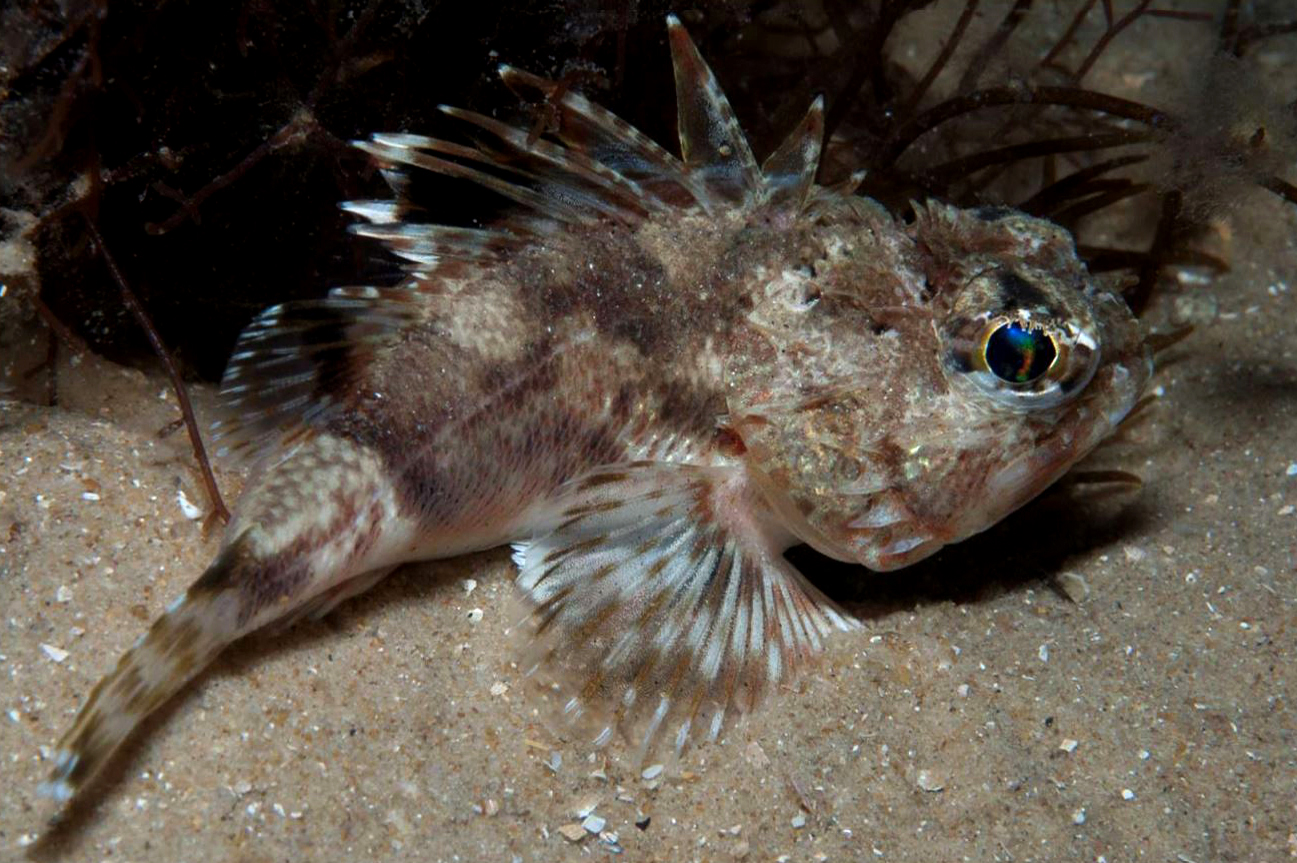Little Gurnard Perch, Maxillicosta scabriceps Whitley 1935
Other Names: Little Scorpionfish

A Little Gurnard Perch, Maxillicosta scabriceps, at St Leonards, Port Phillip, Victoria. Source: Julian K. Finn / Museums Victoria. License: CC BY Attribution
Summary:
A pale reddish-brown gurnard perch, with irregular darker brown patches forming diagonal saddle like marks along the upper side, and a prominent black blotch on the dorsal fin between the 4th and 9th spines.
This common little scorpionfish relative has venomous fin spines and is responsible for painful stings to unsuspecting swimmers and waders who accidentally step on these otherwise docile fish.
This common little scorpionfish relative has venomous fin spines and is responsible for painful stings to unsuspecting swimmers and waders who accidentally step on these otherwise docile fish.
Cite this page as:
Bray, D.J. 2018, Maxillicosta scabriceps in Fishes of Australia, accessed 27 Jun 2025, https://fishesofaustralia.net.au/home/species/4051
Little Gurnard Perch, Maxillicosta scabriceps Whitley 1935
More Info
|
Distribution |
Endemic to southern Australia, from about Lakes Entrance, Victoria, to the Houtman Abrolhos Islands, Western Australia. Inhabits sandy areas in shallow coastal waters, bays and estuaries at depths of 2–46 m. Little Gurnard Perch are nocturnal, and usually lie buried in sand during daylight hours. |
|
Features |
Dorsal fin XIII, 6–8; Anal fin III, 5; Caudal fin 10–12; Pectoral fin 21–24; Pelvic fin I, 5; Lateral line scales 28–33; Gill rakers 3–4 + 8–9 = 11–14. Nasal bone on each side with 2–3 spines; supraocular ridge (ridge above eye) with 8–13 separate, well developed spines; interorbital relatively deep, depth 1.7–2.2 times in interorbital width. |
|
Feeding |
Carnivore - feeds mostly on crustaceans including mysids, amphipods and oxyrhyncan crabs, carid decapods and brachyrhyncan crabs. |
|
Fisheries |
Taken as incidental by-catch in trawl fisheries. |
|
Species Citation |
Maxillicosta scabriceps Whitley 1935, Rec. Aust. Mus. 19(4): 246, pl. 18, figs 4-5. Type locality: Kingscote, Kangaroo Island, South Australia. |
|
Author |
Bray, D.J. 2018 |
|
Resources |
Little Gurnard Perch, Maxillicosta scabriceps Whitley 1935
References
Coleman, N. 1980. Australian Sea Fishes South of 30ºS. Lane Cove, NSW : Doubleday Australia Pty Ltd 309 pp. (as Neosebastes scabriceps)
Eschmeyer, W.N. & Poss, S.G. 1976. Review of the scorpionfish genus Maxillicosta (Pisces : Scorpaenidae), with a description of three new species from the Australian-New Zealand region. Bulletin of Marine Science 26(4): 433-449 figs 1-10 PDF available, open access
Hutchins, J.B. 2001. Checklist of the fishes of Western Australia. Records of the Western Australian Museum, Supplement 63: 9-50
Hutchins, J.B. & Swainston, R. 1986. Sea Fishes of Southern Australia. Complete field guide for anglers and divers. Perth : Swainston Publishing 180 pp.
Johnson, J.W. & Motomura, H. 2008. Family Neosebastidae. pp. 489-495 in Gomon, M.F., Bray, D.J. & Kuiter, R.H. (eds). Fishes of Australia's Southern Coast. Sydney : Reed New Holland 928 pp.
Kuiter, R.H. 1993. Coastal Fishes of South-eastern Australia. Bathurst : Crawford House Press 437 pp.
Kuiter, R.H. 1996. Guide to Sea Fishes of Australia. A comprehensive reference for divers and fishermen. Sydney, NSW, Australia : New Holland Publishers xvii, 434 pp.
May, J.L. & Maxwell, J.G.H. 1986. Field Guide to Trawl Fish from Temperate Waters of Australia. Hobart : CSIRO Division of Marine Research 492 pp.
Motomura, H., Last, P.R. & White, W.T. 2005. First records of a scorpionfish, Maxillicosta raoulensis (Scorpaeniformes, Neosebastidae), from the Tasman Sea, with fresh colour notes for the species. Biogeography 7: 85-90
Platell, M. & Potter, I.C. 1998. Distributions, size compositions and diets of two abundant benthic ambush-feeding teleosts in coastal waters of south-western Australia. Journal of the Marine Biological Association of the United Kingdom 78(2): 587-608 https://doi.org/10.1017/S0025315400041643 Abstract
Poss, S.G. 1994. Family Scorpaenidae. pp. 477-494 figs 428-441 in Gomon, M.F., Glover, C.J.M. & Kuiter, R.H. (eds). The Fishes of Australia's South Coast. Adelaide : State Printer 992 pp. 810 figs.
Whitley, G.P. 1935. Studies in Ichthyology No. 9. Records of the Australian Museum 19(4): 215-250 figs 1-11 pl. 18 PDF available, open access














